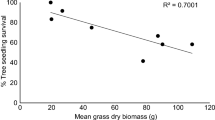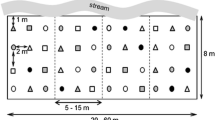Abstract
We studied the conditions that permit the shrub, Cordia multispicata, to establish in Amazon pastures and the potential role of this shrub as a ‘succession facilitator’ near the town of Paragominas, Pará State, Brazil. Local disturbances that reduce cover such as grazing and burning helped C. multispicata establish in pastures in active use. Germination of C. multispicata was significantly improved on sites subjected to simulated grazing and seedling growth was hastened following pasture burning. We found that below-ground competition, evaluated using root ingrowth cores, was reduced by burning and grazing. Recently abandoned pastures are frequently composed of a mix of forbs and grasses but as succession proceeds a mosaic of more discrete vegetation patches appears. At our site, a five-year-old abandoned pasture, grass patches (primarily Panicum maximum) and shrub patches (mainly C. multispicata) were common. We compared physical and biotic characteristics of zones dominated by C. multispicata and P. maximum and found: (1) the rain of bat and bird dispersed seeds of woody species was much greater in the zones of C. multispicata (92 seeds/m2/year) than in the patches of grass (6 seeds/m2/year); (2) the density of woody seedlings was eight times greater in the C. multispicata patches (0.65/m2) than in the zones of P. maximum (0.08 woody individuals/m2); (3) soil nutrient availability and litter nutrient concentrations were greater in the shrub zones than in the grass zones; and (4) photosynthetic photon flux density at the soil surface was generally more favorable for rainforest tree seedling growth in C. multispicata patches (16% of full sunlight) as compared to the grass zones (7.7% of full sun). We conclude that the shrub, C. multispicata, acts as a magnet, attracting volant seed vectors, and as a nurse plant, facilitating the establishment of woody species in abandoned Amazon pastures.
Similar content being viewed by others
References
Buschbacher, R., Uhl, C. & Serrão, E. A. S. 1988. Abandoned pastures in eastern Amazonia, II: Nutrient stocks in the soil and vegetation. J. Ecology 76: 682–699.
Camarão A. P. Simão Neto M., Serrão E.A.S., Rodrigues, I. A. & Lascano C. E. 1988. Identificação e composição quimica de espécies invasoras de pastagens cultivadas e consumidas por bovinos em Paragominas, Pará. EMBRAPA CPATU. Boletim de Pesquisa, No. 104. 62 pp.
Dias Filho, M. B. 1990. Plantas invasoras em pastagens cultivadas da Amazônia: estrategias de manejo e controle. EMBRAPA/CPATU. Documentos 52.
Dutra, S, Serrão, E. A. S., Veiga, J. B. da, Simão Neto, M. & Vasconcelos R. A. 1990. Sistemas de produção pecuária na região de Paragominas, Pará. Brasil. In: Reunion de la Red Internacional de Evaluacion de Pastos Tropicales, Lima, CIAT. v. 2. pp. 1083–9.
Fearnside, P. M. 1989. A prescription for slowing deforestation in Amazonia. Environment 31: 16–20.
Guevara, S., Purata, S. E. & Van der Maarel, E., 1986. The role of remnant trees in tropical succession. Vegetatio 66: 77–84.
Kellman, M. 1979. Soil enrichment by neotropical savanna trees. J. Ecol. 67: 565–577.
Kellman, M. 1985. Forest seedling establishment in neotropical savannas: transplant experiments with Xylopia frutesces and Calophyllum brasiliense. J. Biogeogr. 12: 373–379.
Lorenzi, H. 1982. Plantas daninhas do Brasil. Nova Odessa, São Paulo.
MacKeague, J. 1978. Manual on soil sampling and methods of analysis. 2nd edition. Ottawa, Canadian Society of Soil Science.
Marsh, B. 1971. Measurement of length in random arrangements of lines. J. Appl. Ecol. 8: 265–67.
Murphy, L. S. & Riley, J. P. 1962. A modified single solution method for the determination of phosphate in natural waters. Anal. Chem. Acta. 27: 31–36.
Nelson, W. L., Mehlich, A. & Winters, E. 1953. The development, evaluation and use of soil testes for phosphorus availability. In: Pierre, W. H. & Norman, A. G. (eds.), Soil and fertilizer phosphorus. Agronomy 4: 153–88.
Nepstad, D. C., Uhl, C. & Serrão, E. A. 1991. Recuperation of a degraded Amazonian landscape: forest recovery and agricultural restoration. Ambio 20: 248–255.
Uhl, C., Buschbacher, R. & Serrão, E. A. S. 1988. Abandoned pastures in eastern Amazonia. I. Patterns of plant succession. J. Ecology 75: 663–681.
Walkley, A. & Black, I. A. 1934. An examination of Oegtjareff method for determining soil organic matter and a proposed modification of the chromic acid titration method. Soil Science 37: 29–38.
Watrin, O. dos S. & Rocha, A. M. A. 1992. Levantamento da vegetação natural e do uso da terra no Municipio de Paragominas (PA) utilizando Imagens TM/Landsat. EMBRAPA/CPATU. Boletim de Pesquisa, No. 124.
Author information
Authors and Affiliations
Rights and permissions
About this article
Cite this article
Vieira, I.C.G., Uhl, C. & Nepstad, D. The role of the shrub Cordia multispicata Cham. as a ‘succession facilitator’ in an abandoned pasture, Paragominas, Amazônia. Vegetatio 115, 91–99 (1994). https://doi.org/10.1007/BF00044863
Accepted:
Issue Date:
DOI: https://doi.org/10.1007/BF00044863




